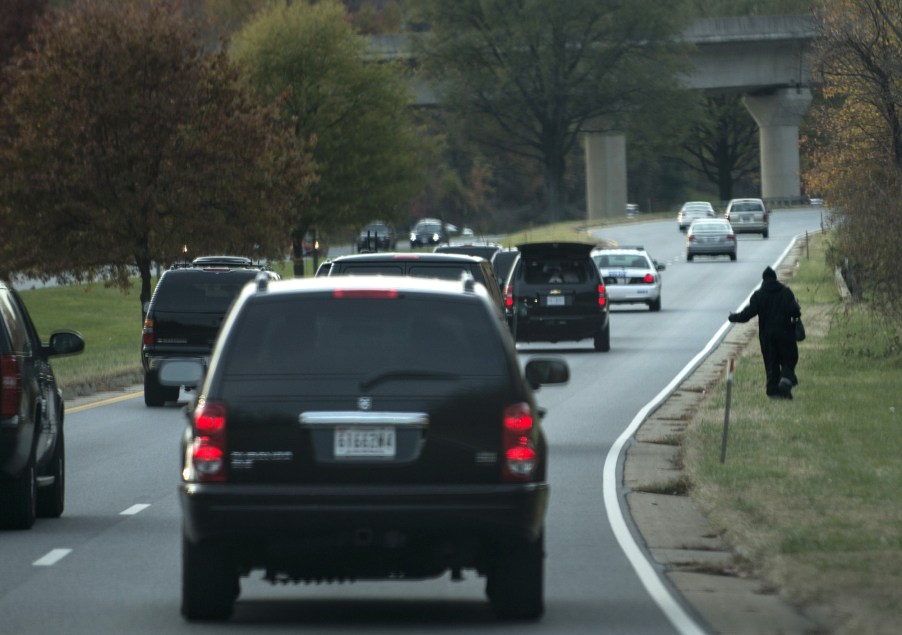
Can You Safely Hitchhike?
Some might remember when it wasn’t uncommon to see a roadside traveler with their thumb out, looking for a ride. Safety concerns, particularly among Westerners, greatly reduced the number of hitchhikers on U.S. roads. But hitchhiking remains a popular travel method in other parts of the world.
Can you still legally hitchhike in the United States and, if so, where? If you end up hitchhiking, how can you do it safely? We’ve got the answers.
The dangers of hitchhiking
When hitchhiking, you’re always risking your safety by getting into a stranger’s vehicle. The person offering you a ride might be a good citizen and will get you a little farther on your travels. Bonus points if you find one who’s also a decent conversationalist.
But if the person who stops on the side of the road has poor intentions, it’s important to know the warning signs, Art of Manliness explains. Here are some red flags.
Before getting in, quickly glance over the person’s vehicle. If it’s dirty inside and out, smells foul, and is littered with trash, you might be dealing with a person with misplaced priorities. Best-case scenario, they’re like your super-messy college roommate. Worst-case scenario, they care as little about safety as they do hygiene.
If you see empty alcohol containers or drug paraphernalia scattered inside, you should probably turn down that ride.
Also, pay attention to the person offering you the ride. Do they avoid eye contact with you? Is there too much eye contact? If something seems off, they might have something to hide.
If there’s more than one person in the vehicle, you’ll want to be careful. That’s because if they have bad intentions, you’re already outnumbered.
The driver’s mood is another consideration. If they seem angry, controlling, or impatient, you might want to turn down the ride. Best-case scenario, the entire ride will be uncomfortable. Worst-case scenario, the person could pose a threat.
Last, even if you see none of those warning signs but your gut still tells you something is amiss, walk away.
Where is hitchhiking illegal?
According to the New York Times, hitchhiking on limited-access highways is illegal in all U.S. states except Arkansas, Kentucky, Missouri, North Carolina, and South Carolina. If you stay off the pavement on secondary roads, hitchhiking is generally allowed in all states except Hawaii, Nevada, New Jersey, North Dakota, and Wyoming.
Many hitchhikers find the police and local authorities helpful. In New Brunswick, New Jersey, where Douglas College and Rutgers University students frequently hitchhike, local police often offer them safe rides. After over 50 interviews with hitchhikers, the Times team learned police officers were allies who often offered safe, free rides.
How to hitch a ride safely
Though there are more horror stories about hitchhiking than tales of good experiences, you can do several things to keep yourself safe if you end up giving it a try.
Experienced hitchhiker Matt Karsten told Nomadic Matt that in his own experience, he has encountered “weirdos,” but he rarely encounters dangerous situations. He explained that on a recent adventure, out of 36 rides, he encountered two or three socially awkward drivers.
When hitchhiking, be prepared for any situation because there’s still risk involved. Take a photo of any car you get into, make sure the license plates are clearly visible, and send that image to a trusted friend or family member before you get in.
If you feel uncomfortable or threatened once you’re in someone’s vehicle, ask the driver to stop and let you out at the next public area or exit. Invent an excuse if that would make it easier. If the driver refuses to stop, remind them about the photo of their vehicle and plates you sent to others.
Karsten added that you could grab the steering wheel or emergency brake to cause a minor accident if you truly feel you’re in danger. However, even minor car accidents can still kill or seriously injure occupants and other motorists.


